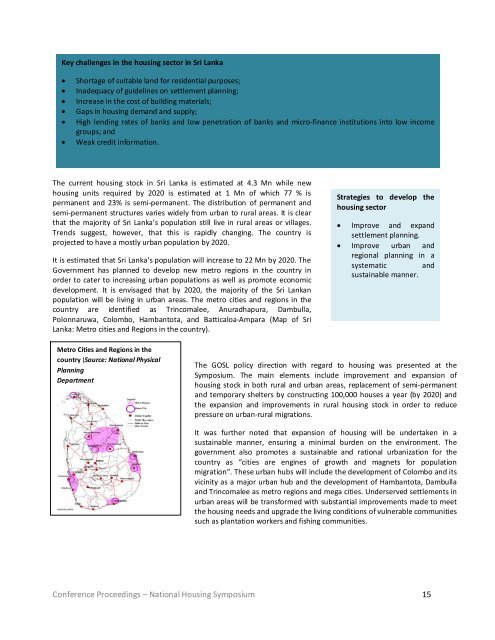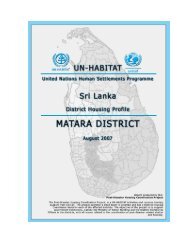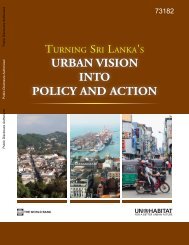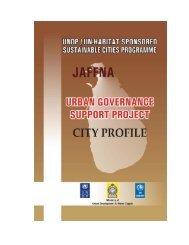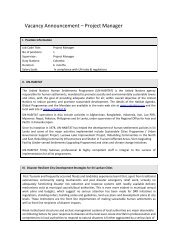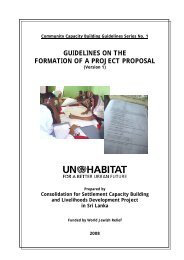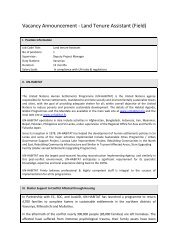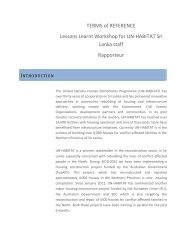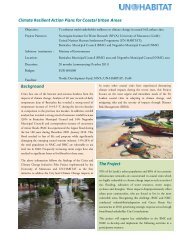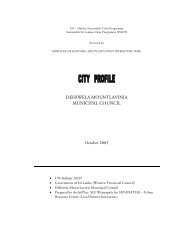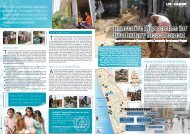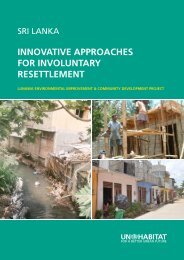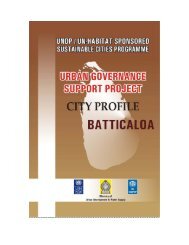Conference Proceedings : âJANASEVANAâ National ... - UN HABITAT
Conference Proceedings : âJANASEVANAâ National ... - UN HABITAT
Conference Proceedings : âJANASEVANAâ National ... - UN HABITAT
You also want an ePaper? Increase the reach of your titles
YUMPU automatically turns print PDFs into web optimized ePapers that Google loves.
Key challenges in the housing sector in Sri Lanka<br />
• Shortage of suitable land for residential purposes;<br />
• Inadequacy of guidelines on settlement planning;<br />
• Increase in the cost of building materials;<br />
• Gaps in housing demand and supply;<br />
• High lending rates of banks and low penetration of banks and micro‐finance institutions into low income<br />
groups; and<br />
• Weak credit information.<br />
The current housing stock in Sri Lanka is estimated at 4.3 Mn while new<br />
housing units required by 2020 is estimated at 1 Mn of which 77 % is<br />
permanent and 23% is semi‐permanent. The distribution of permanent and<br />
semi‐permanent structures varies widely from urban to rural areas. It is clear<br />
that the majority of Sri Lanka’s population still live in rural areas or villages.<br />
Trends suggest, however, that this is rapidly changing. The country is<br />
projected to have a mostly urban population by 2020.<br />
It is estimated that Sri Lanka’s population will increase to 22 Mn by 2020. The<br />
Government has planned to develop new metro regions in the country in<br />
order to cater to increasing urban populations as well as promote economic<br />
development. It is envisaged that by 2020, the majority of the Sri Lankan<br />
population will be living in urban areas. The metro cities and regions in the<br />
country are identified as Trincomalee, Anuradhapura, Dambulla,<br />
Polonnaruwa, Colombo, Hambantota, and Batticaloa‐Ampara (Map of Sri<br />
Lanka: Metro cities and Regions in the country).<br />
Strategies to develop the<br />
housing sector<br />
• Improve and expand<br />
settlement planning.<br />
• Improve urban and<br />
regional planning in a<br />
systematic and<br />
sustainable manner.<br />
Metro Cities and Regions in the<br />
country (Source: <strong>National</strong> Physical<br />
Planning<br />
Department<br />
The GOSL policy direction with regard to housing was presented at the<br />
Symposium. The main elements include improvement and expansion of<br />
housing stock in both rural and urban areas, replacement of semi‐permanent<br />
and temporary shelters by constructing 100,000 houses a year (by 2020) and<br />
the expansion and improvements in rural housing stock in order to reduce<br />
pressure on urban‐rural migrations.<br />
It was further noted that expansion of housing will be undertaken in a<br />
sustainable manner, ensuring a minimal burden on the environment. The<br />
government also promotes a sustainable and rational urbanization for the<br />
country as “cities are engines of growth and magnets for population<br />
migration”. These urban hubs will include the development of Colombo and its<br />
vicinity as a major urban hub and the development of Hambantota, Dambulla<br />
and Trincomalee as metro regions and mega cities. Underserved settlements in<br />
urban areas will be transformed with substantial improvements made to meet<br />
the housing needs and upgrade the living conditions of vulnerable communities<br />
such as plantation workers and fishing communities.<br />
<strong>Conference</strong> <strong>Proceedings</strong> – <strong>National</strong> Housing Symposium 15


